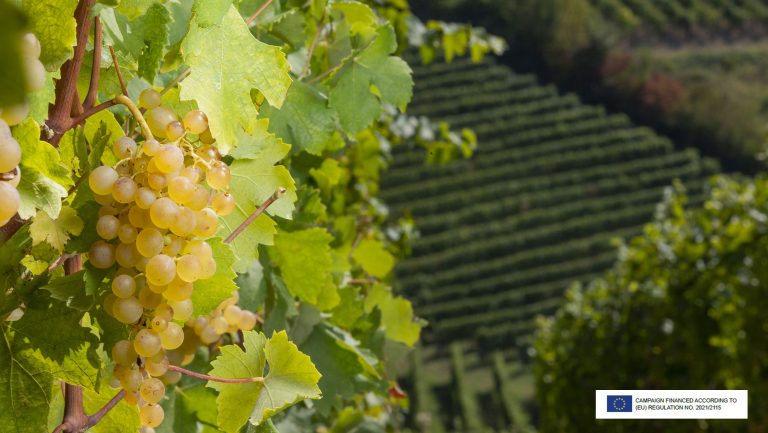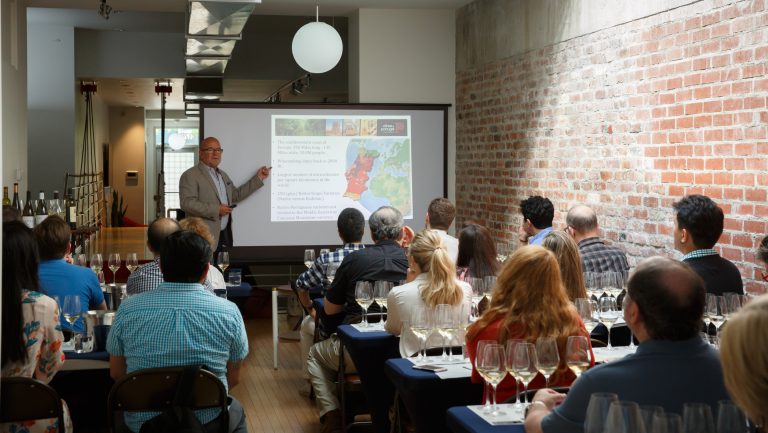This advertising content was produced in collaboration with our partner, Gavi DOCG.
Wine professionals have long looked to the hills of Piedmont for inspiration, whether from the big Bs of Barolo and Barbaresco or the lesser-known red varieties of Ruché and Freisa. However, when it comes to the region’s white wines, it’s all about Gavi.
While Italians possess a fond familiarity for this wine, Gavi (which is made entirely from the Cortese grape) remains elusive to many American drinkers. Yet, Gavi’s diversity in wine styles and soils, age-worthiness, and versatility on the table make it a standout choice for wine professionals looking to add selections of nuance and discovery to their programs.
In 2022, the consortium for Gavi, Consorzio Tutela del Gavi, launched a road show to introduce trade and media to the potential of the wine, and the Gavi World Tour returns this year with tastings and masterclasses run by key opinion leaders, offering participants the chance to taste and learn through side-by-side comparison. While Gavi is widely known as young, fresh, and easy-to-drink, there’s a lot more nuance to the Italian wine than many consumers and wine professionals realize.

Don’t miss the latest drinks industry news and insights. Sign up for our award-winning newsletters and get insider intel, resources, and trends delivered to your inbox every week.
Gavi’s Legacy of Winemaking
Gavi is many things—a place, a wine, perhaps a mindset for its makers, but also the liquid conveyance of centuries of history. Positioned along Piedmont’s southeastern corner bordering Liguria, Gavi was long an outpost for the Genoese. In the 17th century, the Genoa nobility built grand summer homes which remain today, several as wineries. The Cortese grape became the wine of the aristocracy, with plantings spreading across the communes, and Cortese developed a reputation as a reliable dry, crisp, refreshing white wine.
Jumping ahead a few centuries, Gavi earned DOC status in 1974, later elevated to DOCG status in 1998. The Gavi DOCG denomination includes all or part of the territories of 11 municipalities in the province of Alessandria: Bosio, Capriata d’Orba, Carrosio, Francavilla Bisio, Gavi, Novi Ligure, Parodi Ligure, Pasturana, San Cristoforo, Serravalle Scrivia, and Tassarolo.
The Region’s Many Soils Lend Diversity to its Wines
Gavi, located in the southeast of Piedmont, has a distinct climate that sees cold winters and warm summers with significant diurnal temperature swings that help preserve acidity and enhance aromas, while the sea breeze coming from nearby Genoa adds flavor to the Piedmont’s signature white wine.
Gavi’s key soil is limestone, a relic from ancient ocean beds. Known for its porosity and high pH, limestone provides good drainage while retaining water during dry spells. It’s an ideal soil for crafting wines of high acidity with brightness, elegance, and tension. Other soil types include red volcanic and clay.
Jessica Munoz, the restaurant manager at Fotografiska in New York City, discovered the diversity of Gavi during a tasting at the 2023 World Tour. “It was interesting to taste how [much] the wine structure changes with the type of soil it grows in,” she says. Clay soils, for example, are typically heavier, rich in nitrogen, and excellent for cooling down vine roots and water retention, and wines from clay can often be noted for their roundness and generosity. Whereas the red volcanic soil is derived from ancient eruptions leaving deposits rich in minerals, such as iron, which lends a rust-colored hue to the dirt and a mineral streak to the wine.
Cellar Innovations and Bottle Aging in Gavi
The various expressions of Gavi result from a blend of climate and soil, but also from winemaker attention and intention. Gavi DOCG rules allow Cortese to be made in still, sparkling, spumante, and riserva styles. Typically, Gavi DOCG wines are dry, expressing a mix of aromas and flavors spanning lemon, apple, and pear to melon and peach with occasional nuttiness. A spray of salinity or mineral edge might be credited to limestone and volcanic soils, proximity to the sea, or all three. Most Gavi DOCG wines have a light to medium body with fresh acidity and a notable structure that allows producers to play with texture through skin contact, barrel, and bottle aging.
The availability of aged Gavi DOCG, however, remains scarce. Paul Caputo, wine critic, writer, and former distributor of Italian wines in the U.K., says Cortese’s natural acidity lends itself to longer aging. “There’s no reason why it can’t age well,” says Caputo, noting the limited supply of older vintages.
Aged Gavi develops layers of depth and breadth, providing a richer drinking experience that lingers on the palate. Even allowing a bottle the minimum one-year of aging mandated for the more prestigious Riserva category can prove transformative.
“In recent decades, there was no market for age-worthy Piedmont whites, so producers didn’t make them,” says Caputo. “Improved winemaking techniques have revealed that these white wines can age longer. Producers are experimenting with lees aging and other methods to impart longevity.”
Consumer perception hasn’t caught up to Gavi’s potential yet and that presents an opportunity for discovery. “A challenge for aged Gavi is […] the casual consumer who has been taught that Gavi is inexpensive, released early, and designed for early consumption,” says Caputo.
Diversity and Versatility on the Table
As with most Italian wines, Gavi complements dishes of the region. The fresh, light styles work well with pesto Genovese, vegetables, seafood, and white meat. John Dillon, the bar manager for New York City’s Barbuto, has poured a Gavi DOCG by the glass for nearly 10 years, and finds it a good fit for the restaurant’s Californian-meets-Italian menu.
“Gavi holds a staple place for us. It’s like a little black dress; it always works, and it fits nearly any occasion,” he says. Dillon pairs Gavi with one of the restaurant’s most famous dishes: the JW Pollo Al Forno. “A nice clean glass of Gavi works beautifully with roast chicken and with salsa verde,” he says.
At Harry’s in West Palm Beach, Florida, sommelier Nicole Mollison has sold Gavi since opening in June 2023. “With its crisp mineral-driven texture and zippy citrus flavors, I suggest Gavi with dishes like Harry’s market oysters, Maine lobster cocktail, or our branzino with lemon-thyme vinaigrette,” she says, recommending it to their more open-minded guests.
“When you’re talking about Italian white wines, many people recognize Pinot Grigio, and usually the conversation ends there,” says Mollison, but “to showcase the versatility of Italy’s white wines, we think Gavi DOCG must be mentioned.”

Dispatch
Sign up for our award-winning newsletter
Don’t miss the latest drinks industry news and insights—delivered to your inbox every week.









